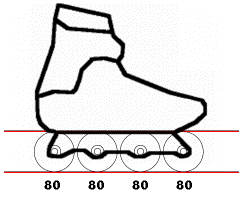
 |
This is a stable setup that
suits most beginners and occasional rec skaters, providing good
balance, speed stability, but limited manoeuvrability. This setup is
easiest to control when practicing slides. |
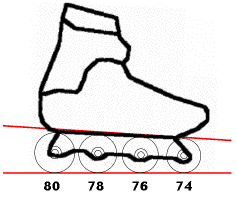 |
Benefits/Downsides: still
quite good speed capabilities and speed stability (you sacrifice a tad
at the top end), rotates a bit better. This position shifts your weight
forwards, keeping you in a perpetual sprint position. This can be very
comfortable, and can also be very helpful if you have problems with
your weight shifting backwards resulting in backwards falls. This setup
works well for slides, too, and allows extending the useful life of
your wheels (see comment on wheel rotation below). |
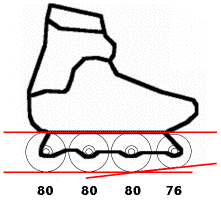 |
Benefits/Downsides:
you're rolling on either 3 or 2 wheels. This means that you have less
directional stability at speed, a lower tolerance for speed wobble, but
a better response to rotational movement. A very good trade-off if you,
for example, would like to use the same setup for street and hockey
skating. |
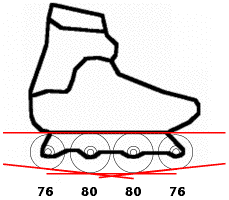 |
Benefits/Downsides:
a lot like the front rocker above, but more extreme - you're on 2
wheels at all times! This setup mimics an Ice Skate blade:  This setup is mainly used for playing hockey, or for slalom; skating at higher speeds - and slides - become very hard to control. Frequently the wheel sizes are smaller than indicated here (I sometimes use 50-60-60-50) which provides a little bit more control (and less speed, which is not an issue here). |
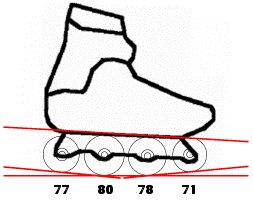 |
Benefits/Downsides:
Very similar to the full rocker above, but with your weight more
forwards, which brings your ankles and knees into a more natural
position and make intricate footwork easier. This is my preferred setup
for slalom/freestyle, and it allows extended wheel use (see comment on
wheel rotation below). |
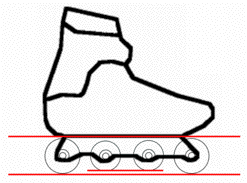 |
This
setup is only used in aggressive skating. It provides easier access to
the frame (which provides less resistance and wears less) when
grinding ledges & rails - frequently the inner wheels are either
very hard, or are replaced
with hard plastic blocks altogether, as they don't need to rotate at
all. If used
for rolling then this setup is very similar to a flat setup, but with
higher wear on the two rolling wheels. |
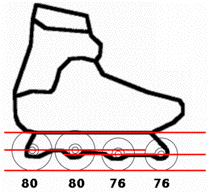 |
The
Salomon FSK EA frames don't have the axle holes on the same level -
this is what Salomon calls a 'HiLo' setup, but which, in reality, is a
flat setup with different wheel sizes. If you want to create any of the setups above on this frame you have to subtract twice the axle height difference (2mm on these frames) from the 'normal' wheel size (think about it... radius vs diameter...:), e.g. the same proper HiLo from above requires 80-78-72-70 wheels now. |